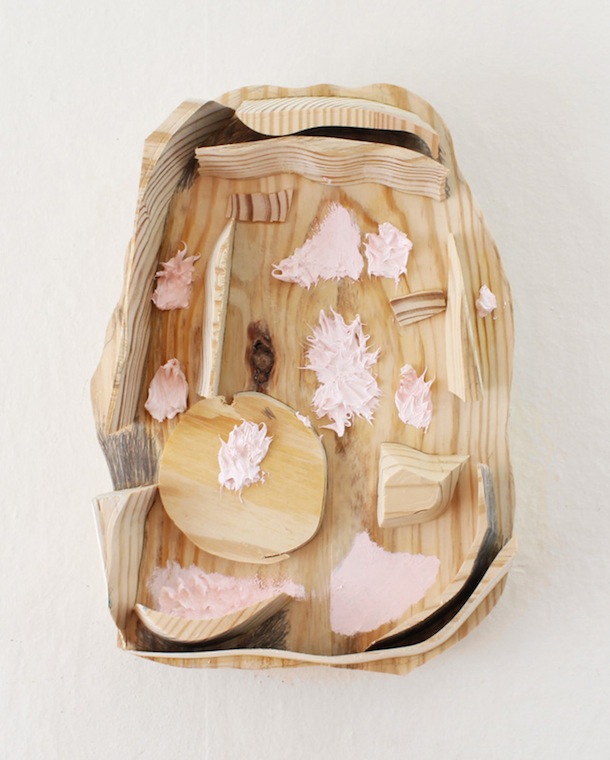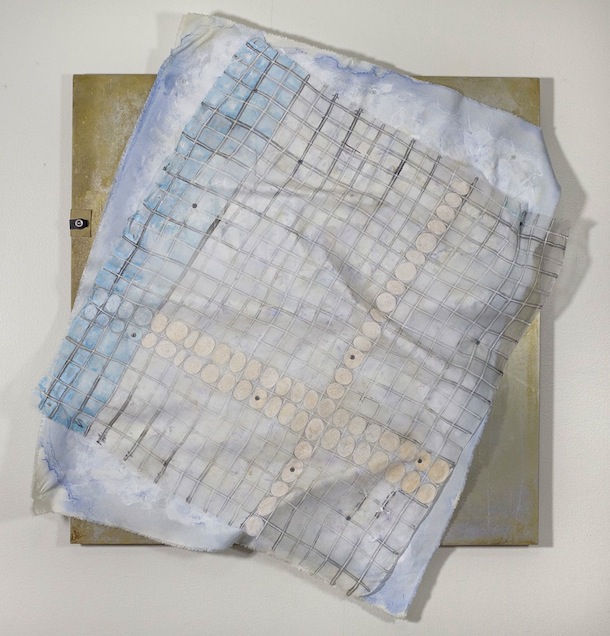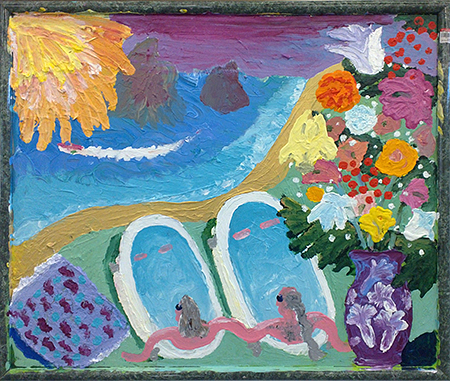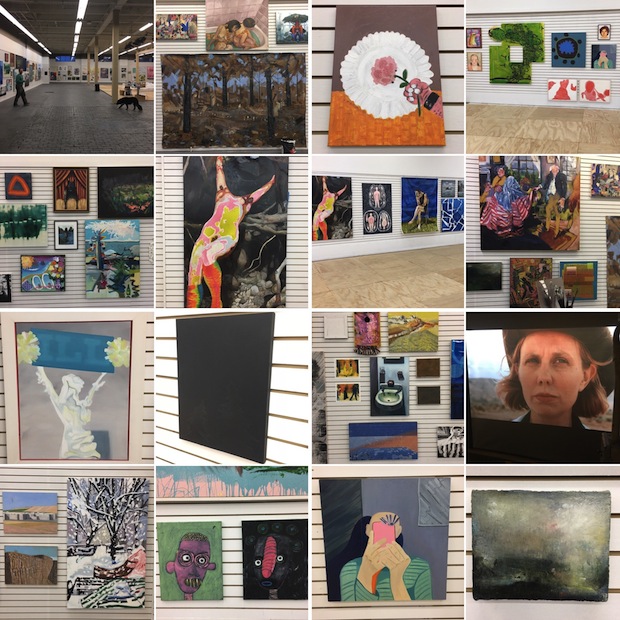
Painting’s Not Dead
Thursday, December 8, 2016
by MARGO VANSYNGHEL
The debate about whether or not painting is dead has continued, with sweeping declarations, for almost 200 years now, yet here were are, surveying American Painting Today. This is the lofty title of a new exhibition in the V2 space on Capitol Hill (opening with a party tonight), hoping to prove that painting is alive and kicking in Seattle.
More than a hundred paintings are hung salon-style across the striped walls of Capitol Hill’s former Value Village, which is living its last days. At the end of this month, the auto row-era building will be redeveloped into office and retail space and the temporary art space there will close. The current walls will not survive—yet for the exhibit, it all started with those off-white wooden walls, formerly hung with second-hand treasures of a newly forgotten past. “The walls are so specific to this place,” says exhibition organizer Matthew Offenbacher. “I thought they would make a visually interesting background for a huge painting exhibit.”
He continues, “Seattle is not often thought of as a great city for painting. I wanted to show the variety of amazing painting that’s being made here.”

Tuan Nguyen, 'SuGaR,' graphite pencil, oil paint, wood, 14.5 x 10.5 x 3", 2015.
The array of works, in various gradations of abstraction and three-dimensionality, is impressive. Take Emily Gherard’s modest-sized graphite-and-staple painting, tucked away in a corner, or Robin Green’s found cookie sheet, which doubles as a canvas and holds a dried-out, wrinkled white fabric, in turn a background for ink spatters. Julie Alexander uses repurposed fabric to hang her painting, titled “My Ankle Your Foot,” with drapes, like a window. Next to that, two brightly colored wooden bowl-shaped assemblages by Tuan Nguyen are painted in bright colors and dotted with curious sculpted shapes, like sawdust teeth or cotton candy paint drops.

Robin Green, 'baked white,' silks, acrylic, ink, found cookie sheet, rivets, 11 x 15", 2016.
Among the 94 artists included, many seem to take the word painting lightly. That’s a good thing, certainly when Philip Miner does so, with his “Profit, Cher Prophète,” a four-panel ink-jet print on fabric, or Neal Fryett, who used photographic prints clipped to sheets of Arches paper. There are plenty of local luminaries such as Ryan Molenkamp, Francisco Guerrero, Kelly Bjork and Joey Veltkamp (A horse! A rainbow! It’s exactly what the show needs.)
When Offenbacher invited artists to the show, he also asked them to suggest other artists. Every suggestion made it into the exhibition. In the end, he included work from artists he didn't know at all.
“It was a good way to reach beyond my own circle,” Offenbacher says. He prefers the epithet “organizer” instead of “curator;” for him, the curating was done by the artists. “A curator would have never left so much of it up to chance. That’s why there’s a certain randomness to it. Also: I didn’t plan it as a comprehensive survey.”
American Painting Today is an ambitious title for an exhibition we shouldn’t consider a comprehensive survey, but given Offenbacher’s humor, it comes with a wink.
“If the Whitney Museum in New York organizes a show by the same title, with mostly local—New York—artists, people are totally fine with it," he says. "The title is a commentary on how local art is marginalized compared to art made in places like New York or Los Angeles.”
Offenbacher, himself a painter, has long explored institutional framing and the power divide between the individual and institutional through writing, actions and exhibitions. Among his recent projects is Deed of Gift, for which he used the $25,000 prize he won from the Neddy Artist Award in 2013 to buy local art with feminist and queer themes to donate to Seattle Art Museum. But the presidential election has left Offenbacher’s context charged: The title and the show became something less ironic and more earnest. Can a group of artists, and by extension American society, come together as a community?
“For me, the social interaction is as important as the paintings,” Offenbacher says. “This show is mainly an attempt at community-building.”
The day a dozen volunteer artists came together to hang the work, Offenbacher didn’t decide precisely where the paintings should go. He instead eschewed traditional curatorial input by presenting artists with an intake form comprised of seven symbols—sunset, mushroom, triangle—and invited them to select the ones they felt related to their work. Later, works were clustered based on chosen symbols.
In these hostile times, American Painting Today should take pride in its literal inclusivity. However, the show’s greatest strength may also be its greatest weakness. A curator’s firm hand might be what this exhibition needed, to group works and filter out lesser paintings. At the same time, the overdose of styles suggests that both painting and community-building are nowhere close to dying. It's also a reminder that, despite sentiment to the contrary, this will likely not be the last time we’ll be overwhelmed by a staggering amount of art in this hyper-developing city.

“American Painting Today”
Editors’ Roundtable
Column by Matthew Kangas

Forrest Perrine, "Finger painting w/Cialis, vase and speedboat," 2016, acrylic on found frame
Periodically, Seattle’s art community stages its own exhibits, usually to make a point about being ignored by local art galleries and museums. “American Painting Today” is set up in an abandoned Value Village charity thrift shop on Capitol Hill [located at 1522 11th Avenue through December 17th—Ed.]. The results of such an undertaking are necessarily mixed. In this case, 39 well-known artists share the grungy space with 54 virtual unknowns. Matthew Offenbacher, the self-appointed juror, invited a number of friends who then invited other friends — all of whom were free to send whatever they wished, one or two paintings each. Nothing was really curated or selected; nothing was rejected. Adamantly denying he is a curator, Offenbacher nonetheless deserves the credit (and some of the blame) for bringing together area artists who are committed to the medium of painting at a pivotal time. Conceptual artists were unsuccessful at killing painting; with its two-dimensional surfaces open to social and political imagery, painting has become more relevant than ever.
Displayed salon-style in tiered rows on three long walls without any labels or prices, selections are seen under crowded circumstances that make it more difficult for abstract or minimalist pictures to be seen to their best advantage than for figurative or representational works. Because of the artist-referral method and artists’ self-curating, viewers’ responses will hinge on whether they have prior or no familiarity with a given artist. “American Painting Today” (even the title is a sly joke) is a modest, hometown effort, but one with considerable pleasures and delights among which are interspersed disappointments. How could it be otherwise? Quality control is replaced by lots of good will.
Among the figurative-narrative painters, Forrest Perrine’s “Finger Painting with Cialis, Vase and Speedboat” is the funniest, a crudely painted scene lifted from the erectile dysfunction TV ad with a man and woman in side-by-side bath tubs. It joins other folk-art-like entries, including works by Joey Veltkamp, Shaw Osha and Denis Fitzpatrick. Painted in the same vein, but more formally complex, “Fixated” by Barry Johnson is a tumult of hurtling figures in a crowded consumer environment.
Sobering images that play into the new artist-as-Cassandra trend, paintings of prisons by Buddy Bunting stand out, as do ecological warnings by Nathan DiPietro (“Rain Columns at Sunset”), Helen O’Toole (“Shelter”), Laura Hamje (“Scorched Earth”), Timothy Cross (“Rain”) and Ryan Molenkamp (“Fear of Volcanoes #80”).
Textiles and recycled or newly knit fabrics comprise a whole mini-section that is filled with considerable promise, offering a fresh perspective on painting’s links to craft. Indeed, during conceptual art’s heyday, painting was referred to as the “sixth craft” after clay, glass, fiber, wood and metals. Among these artists, Paul Komada is by far the most interesting. His “Obviously Covered and Masked” is a zany combine of argyle sweater fragments and a see-through canvas on its stretcher with matching painted sweater pattern. Margie Livingston also deconstructs painting. Her stretched canvas faces the wall, a relic after a performance in which she dragged the painting on her back, weighed down by rocks attached to a string. The historical burden of painting? “Pink Panther” by Sean Barton uses pink satin and fringe as a base for a faint black inkjet image. Nicholas Nyland’s “Soft Painting” further undermines traditional definitions with its odd ceramic add-on. Linda Davidson expropriates a bedspread upon which to paint.
The younger, mostly as yet unfamiliar artists, many of whom have moved to Seattle after attending prestigious art schools back east and elsewhere, provide some welcome surprises. Sasha Ferré, Doug Parry, Andrew Rubinstein and Michael Ottersen show promise of great things to come.
Among my critic’s choice “award” winners are a timely “Tribute to Betsy Ross #6” by Ray Mack that channels Larry Rivers; Sasha Ferré’s remarkable painting of the artist taking her own selfie (it obscures her face); “Where Did You Sleep Last Night?” by Victoria Haven, a black-on-black evergreen tree scene commemorating the homeless; Julie Alexander’s “Duet,” an ethereal abstraction of acrylic on see-through organza dress fabric; and I want to see more of Francisco Guerrero’s dark, moody landscapes such as “At the Cle Elum River — Northwest Gothic.”
Finally, abstraction, another recent survivor of assassination attempts, shows every sign here of recovery and revival. Older stalwarts like Lisa Buchanan (“Tailspin”), Ken Kelly, Harold Hollingsworth and Susan Dory are joined by David Hytone, Julie Alexander, Sue Danielson and Margaret Watson. Given the cruelly crowded hanging and riot of recognizable imagery surrounding them, these artists nonetheless provide an encouraging respite, all the better to assist in contemplating the bright, next future of painting.

December 5, 2016
American Painting Today: A High-Falutin Thing in a Precarious Place
by Jen Graves

Yeah, I took all those pictures and cobbled them together. And there are plenty more where those came from, at V2 starting December 8. JG
American Painting Today is a great big exhibition with a very official-sounding title. But the grandiosity, on paper, of an exhibition of 120 paintings by 90 artists, is exposed as something else: a precarious undertaking about to be wiped away, like the dusty, ugly Value Village store that used to be inside this same space on Capitol Hill. Artists have taken over this space and called it V2 for most of 2016. Now they'll have to leave, and the building will be redeveloped into something more expensive and more exclusive.
Seattle artist Matthew Offenbacher organized the show (which is sponsored by Hedreen Gallery) by inviting painters, who then invited other painters. The artists sent him what they planned to show, and then many of them turned to darker, more difficult pieces after the election. Coming together this way, they form a community-building exercise that also turns out to be a strong survey of the vast range of possibilities for what a painting can be.
A few standouts from the tile of 16 pictures above: Mark Takamichi Miller's terrible flayed woman based on a photograph he found online (see Rembrandt's famous flayed ox from 1655); Sasha Ferré's droll selfie portrait Me (I Mean You); the pairing (at the very bottom left) of Susanna Bluhm's snowy candy-city landscape with Buddy Bunting's desert prisons; Francisco Guerrero's grotesque Lady Liberty/cheerleader; and next to that (above Bluhm and Bunting), a black-on-black image by Vic Haven reminiscent of the New Yorker's Twin Towers cover, but this time, with evergreen trees instead of towers.
Another highlight, sharing the space with American Painting Today, is a mini-survey of videos, prints, and installations by Vis-à-Vis Society. It's such a pleasure to see a full collection of their works. Don't miss Down Hill in the stairwell.
The opening is during Capitol Hill Art Walk on December 8.





